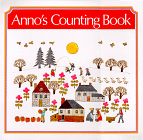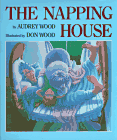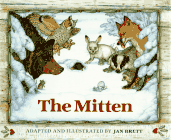Math Month in the Library
This article by Carol Otis Hurst first appeared in Teaching K-8 Magazine.
If your math skills are as weak as mine, it will come to a shock of the entire faculty when you announce that this month is Math Month in the library.
Start with a bulletin board based on How Much Is a Million? by David M. Schwartz and Steven Kellogg (Lothrop, 1985 ISBN 0-688-04050-0). Line a bulletin board with wrapping paper that has stars on it and across it put a statement like "If this bulletin board had a million stars on it, it would be _____ feet long and ____ feet wide."
I don't know how many. I only think of these ideas, I can't do the math. You'll have to figure out how many stars there are on a square foot and go from there, I think.
Put some of the other facts from the book around the bulletin board. Put some books which accent math -- not those boring ones from the 511 section -- at least not most of them. Use picture books that play with numbers and concepts. We'll get to them later in the article. In the middle of the display put a sign that says, "We've Got a Million of `Em -- or do we?"
Start a drive to collect a million pennies for some good cause. You'll probably never make it, but people are usually happy to find a place for their pennies and the amount of space taken up by even 100,000 of those coins is amazing and will help to give the kids some idea of what you're talking about when you deal with millions.
Start a contest asking kids to estimate how many books you have in the library. You'll know precisely, of course, because your inventory is always up to the minute, isn't it? Give a math book prize to the closest estimate.
Play some math games in the library this month. I love the ideas in two of the books by Marilyn Burns with illustrations by Martha Weston: The I Hate Mathematics Book (Little, 1975 ISBN 0-316-11741-2) and Math for Smarty Pants (Little, 1982 ISBN 0-316-11739-0. With an upper grade class, pair off the kids and play the calendar game on page 58 in "Smarty Pants". Kids take turns trying to be the first to say "December 31" There are some rules: The first person can't say December 31 but must give a month and day. The next person must name a later date but can only change either the month or the day, not both. It should take them a while to see how to win it.
With a lower grade, try playing the one on page 44 of the same book where partners make a circle of six dots and take turns drawing line segments between them, each player using a different color marker. The object is to force your opponent into making a triangle in his or her color before you have to.
Hand out papers with a literature math game such as:
Take the number of Little Pigs in the story.
Multiply it by the number of Billy Goats Gruff.
Divide by the number of people going to St. Ives.
Add the number of creatures in the bed at the beginning of Ahlsburg's book.
Add the number against the tide in the book by Bruce Clements.
Add the number of reindeer Santa had in A Visit from St. Nicholas.
Subtract the number of bad ants in Chris Van Allsburg's book.
Divide by the number of planets we have going around our sun.
Divide by the number of wishes we usually get in fairy tales and you get the number Johnny was in the book by Maurice Sendak.
Let the kids have more fun with numbers in literature by making up their own puzzles like the one above.
Accent a new math book each day in the library. Counting books should go on display, maybe with the question "Which one is cleverest?" with a place for kids to vote.

Mitsumasa Anno deserves a spot of honor. All of his books have a little math in them and most, by that ex-math teacher of Japan, are brim full of math concepts. Some of the strongest:
Anno's Alphabet - Crowell, 1975 ISBN 0-690-00540-7
Anno's Counting Book - Harper, 1977 ISBN 0-690-01287-X
Anno's Counting House - Putnam, 1982 ISBN 0-399-20896-8
Anno's Math Games - Putnam, 1989 ISBN 0-399-21615-4
Anno's Mysterious Multiplying Jar - Putnam, 1983 ISBN 0-399-2095-4
Anno's Sundial - Putnam, 1987 ISBN 0-399-21374-0
Topsy-Turvies - Weatherhill, 1970 ISBN 0-8348-2004-8
Anno's Flea Market - Putnam, 1984 ISBN 0-399-21031-8
All In a Day - Putnam, 1990 ISBN 0-399-61292-0
By the way, while you're exposing the kids to the work of Anno, make sure the math teachers know about his work as well. At the back of most of his books, Mr. Anno gives us suggestions for how they might be used to strengthen math reasoning and concepts. Who can ask for more in a math month in the library?
But, since you are asking for more, here are some other books with a math twist:

Don and Audrey Wood's The Napping House (Harcourt, 1984 ISBN 0-15-256708-9). Regular readers of this column are going to think it's the only book I know because I cite it so often, but it's so useful. Math concepts in it include diminishing size and estimation.
I mentioned this one in a previous column too, but only once I think: Alphonse Knows Zero Is Not Enough by H. Werner Zimmermann (Oxford, 1990 ISBN 0-19-540797-0). It's Halloween and Alphonse has a big bowl of candy ready for the trick-or-treaters. He also has a mathematically literate mouse assistant. So, to be sure there are enough candies, Alphonse starts counting and eating and, as the numbers grow larger on the mouse's charts, the bowl grows emptier. Mathematical activities abound. How many does he eat altogether? How many will he need to fulfill the requests waiting at the door when he finishes? How big a bowl do you need to hold that many M & M's?

We did a whole page on using Jan Brett's The Mitten (Putnam, 1990 ISBN 0-399-21920-X). At any rate, we gave several suggestions for using it for math activities: figuring out how big the mitten would have to be to hold average sized animals that somehow fit into it should keep you busy for a while.
The 500 Hats of Bartholomew Cubbins by Dr. Seuss (Vanguard, 1938 ISBN 0-8149-0889-6) counts hats and ends up with the prerequisite number, to be sure, but many of the numbers between one and five hundred are skipped in the interests of avoiding tedium, but with children in the lower grades who need practice in recognizing numerals, you can give each of them a copy of a chart of numerals from one to five hundred and then read the book aloud, asking them to cross out the numbers you mention.
Numbers on a simpler level are used in Patricia Polacco's Thunder Cake (Philomel, 1990 ISBN 0-399-22231-6). Baba's attempt, successful as it turns out, to get the little girl over her fear of thunderstorms is to make a thunder cake. While they're rounding up the ingredients the grandmother instructs the child "When you see the lightning, start counting...real slow. When you hear the thunder, stop counting. That number is how many miles away the storm is." Well, first find out if that's true. Weather books should help and may lead you off on a tangent for a while. They may also tell you how far away a storm is when you first hear the thunder.
There's a wonderful poem in The Random House Book of Poetry for Children, selected by Jack Prelutsky and illustrated by Arnold Lobel (Random, 1983 ISBN 0-394-85010-6). Actually, there are lots of wonderful poems in that collection, but the one I wanted a math focus on is "The Ants at the Olympics" by Richard Digance. It's the tale of the Jungle Olympics, apparently an annual event and the ants who show up each year "are sloggers. They turn out for every event. With their shorts and their bright orange tee-shirts, their atheletes are proud they are sent." The poem is hysterical and replete with potential math: Take the information from the poem and design the equipment for each event. Children can figure out how far the ants, given their size and speed, could walk from January 1st to August 1st (the time that the poem says it takes them to get from their home to the Olympic games site) and, therefore, where their homes and where the Olympics could be. Remember, it's a Jungle Olympics.
After you've played enough with that poem, turn the kids loose to find other poems with a math base or with a math activity that could come from it. "Casey at the Bat" and Sandburg's "Arithmetic" spring to my mind quickly. What's on the tip of your math tongue?
Related Areas of Carol Hurst's Children's Literature Site
Advertisement:
Advertisement:
Advertisement:

